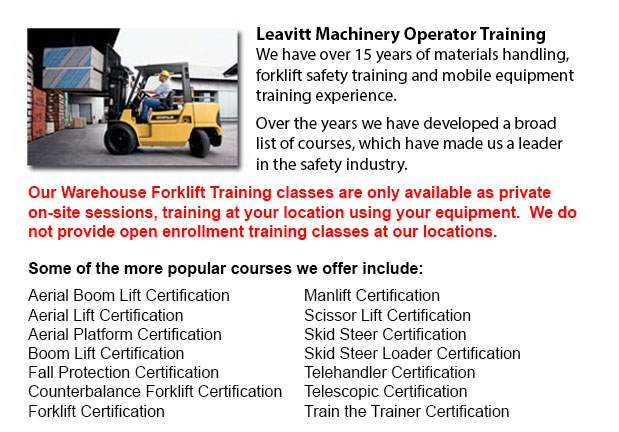
London Warehouse Forklift Safety Training - Companies often face liability for damage and injuries sustained in workplace accidents. Warehouses could be hazardous places to the people who work there. That is the reason why employee safety is a top priority for a lot of businesses. Warehouse safety training is among the most effective methods to protect employees, while minimizing costs associated with injuries and accidents.
Warehouses hold stock that can present various dangers, particularly related to materials handling. Moving stock, either manually or using powered machines, can cause injuries to employees' fingers, hands, toes and feet. Tripping, falling and slipping are common causes of injury. Heavy things could fall off shelves and harm personnel. Forklifts and other machines carry inherent hazards because they manipulate heavily laden pallets. Improper lifting is a common source of back injuries. Even nails, splinters and box cutters can cause harm.
Warehouse conditions can change from one moment to the next, depending on the materials or substances being handling, the duties being carried out and the equipment being utilized. Because of the wide variety of possible hazards in warehouse settings, warehouse operations are regulated by many various standards. There are regulations for storage and material handling, for walking and working surfaces, and regulations governing the use and selection of PPE (personal protective equipment).
Most of the safety rules covered by a business would consist of common sense regulations. Regulations that warehouse personnel must be quite familiar with consist of:
1. If working in a warehouse, safety is a top priority at all times.
2. PPE, like gloves, safety shoes, eye protection and hard hats, must be worn as appropriate.
3. Inspect for hazards and correct them or report them.
4. Understand warning signals and signs - and obey them.
5. Watch where you're going and concentrate on what you're doing.
6. Pay attention to what others are performing nearby - particularly forklifts and other hazardous equipment.
7. Make sure that stacked materials and products are secured and stable.
In order to guarantee a safe warehouse, staff should follow good housekeeping rules. Basic rules for housekeeping involves keeping the aisles and floors clear of items like wires and cords. Never perch items insecurely on a surface. When spills happen, clean up instantly. Throw garbage in right containers. Keep fire exits, fire extinguishers and sprinklers accessible. Put box cutters and other sharp tools away instantly after use. Report tripping hazards such as loose or damaged flooring.
-
London Crane License
London Crane License - Crane operators ought to be "credentialed", that means they must possess a crane operator license or certification. Credentialing is considered a mandatory governmental requirement in order to practice as a crane operator. Obta... More -
London Heavy Equipment Operator Training
London Heavy Equipment Operator Training - Training facilities which offer quality standards in the industry and not just provide field performing tasks but added equipment training are highly sought after. Accredited schools provide students the kno... More -
Telehandler Training in London
Telescopic handlers usually referred to as telehandlers for short, are a very popular piece of heavy construction machinery. They are usually utilized in the agriculture and construction industries. These machines have maximum reaching capacity and c... More -
London Boom Lift Certification
London Boom Lift Certification - Elevated work platforms allow maintenance operations and work to be carried out at heights which could not be reached by any other means. Workers utilizing boom lifts and scissor lifts can learn how to safely operate... More -
London Fall Protection Ticket
London Fall Protection Ticket - Fall-related accidents are the number one reason of death within the construction industry. The potential for fall incidents really increases based upon the kind of work that is being completed within your workplace. T... More -
London Forklift Safety Training
London Forklift Safety Training - Anybody who wants to operate a lift truck should take a forklift safety training program to become a certified forklift truck operator. There are several ways to obtain forklift training. Programs are provided throug... More -
Operator Safety Training, Re-Qualification Training, In-House Instructor Training in London
Lift trucks are used in nearly all warehouse operations and in boat yards and in industrial construction sites. The reach feature of a forklift is a vital component used in various applications like for instance whenever a shelving system is being us... More -
London Boom Lift Safety Training
London Boom Lift Safey Training - Boom lifts are a type of elevated work platform or aerial lifting device that are commonly utilized in construction, industry, and warehousing. Boom lifts can be used in practically any surroundings due to their vers... More

Forklift Certification London
TOLL FREE: 1-888-254-6157
London, Ontario
forkliftcertificationlondon.com
Email Us
About Us


